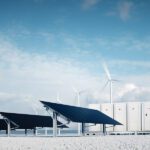COMMENTARY
The future of energy is electric. It is a future that is evolving rapidly, bringing significant changes. Traditional suppliers are scrambling to stake their claims and remain relevant. Market trends point toward a future that is low carbon. The future market will deliver lower costs for some, but higher prices and more power disruptions for others. This transition is being driven by trends that industry experts call “the Three Ds,” that is, decarbonization, digitalization, and decentralization. These three trends are impacting the power grid and will provoke changes that deliver more-reliable power for some customers, but more challenges for others.
Microgrids Will Impact the Energy Market
Microgrids are an example of the three Ds converging. Imagine customers who decide to take control of their energy destinies by installing a combination of distributed energy resources (DERs). DERs can include solar, wind, batteries, combined heat and power (CHP), fuel cells, and more. These elements can be combined to form a microgrid, giving customers the capability to isolate themselves from the electrical grid.
If the power grid goes dark for any reason, microgrids can keep facilities operating. When properly designed, microgrids can help deliver cost-effective, reliable, relatively clean power. These qualities are immensely important for facilities that must operate around the clock, such as hospitals, data centers, airports, manufacturing plants, or wastewater treatment facilities—and the list is growing. In the aftermath of Hurricane Harvey in 2017, major medical centers, as well as some gas stations and convenience stores, were able to continue serving the public thanks to microgrids.
The proliferation of microgrids will have a huge impact on how the energy market works both for those that use microgrids and those that don’t. The growth of microgrids has the potential to create a have/have-not situation in energy, as those without microgrids could face higher costs and more disruption, while those with microgrids will have access to reliable power, even if the electrical grid experiences problems.
Cost Increases for Some Customers
As more organizations embrace microgrids and reduce reliance on traditional power suppliers, or exit the grid altogether, the customer pool shrinks and the fixed costs of transmitting electricity and maintaining infrastructure are spread across fewer customers. So, as the electricity market evolves, customers reliant on traditional suppliers may see costs rise, while also experiencing more power disruptions or reduced power quality due to aging infrastructure with limited resources for upgrades and repairs.
Even as many power companies focus on harvesting energy from more clean, renewable sources, they still face cost pressure. The nature of the electrical grid in the U.S. makes it difficult to predict whether the move to renewables will actually decrease costs for a specific customer, even as costs for wind and solar plummet.
The U.S. electric grid is not managed by a central authority. It is really many separate grids that are interconnected. Some are investor-owned, some are cooperatives, and some are municipal utilities. This results in inconsistencies in equipment investments, technology choices, and other grid management decisions.
States also have their own targets for renewable energy, resulting in diverse strategies. In this sense, the U.S. is like 51 separate countries. At a time when the U.S. is more reliant on power than ever, reliability is declining, both because of the governance issues detailed above, as well as aging infrastructure and the trend toward more-volatile weather events that can disrupt power. Another contributing factor is the lack of a uniform strategy on carbon mitigation to address climate change, with varying goals leading to pricing discrepancies throughout the country.
Low-Carbon Energy and Transmission Costs
While many power generation sources are declining in price, the actual cost for delivering electrons has not changed much. In other words, delivering cheaper power produced by wind farms in Iowa or other rural areas still requires transmission and distribution lines to get to market. Even if the costs of wind and solar dip well below natural gas, overall costs to the average customer may still rise due in part to the cost of transmission, distribution, and other factors.
While lowering the cost of transmission and distribution is challenging, the ultimate game-changer for impacting costs may be the pairing of renewable energy with battery storage. Technologies such as solar, wind, or battery enhancements are evolving so rapidly that cost curves from just two years ago are now completely out of date. Batteries are declining in cost, solar is now cheaper than conventional generation, and wind turbines are becoming larger and more efficient. Right now, natural gas generation picks up the slack from the intermittency of renewables, but in the future, storage technologies will fill more of this void.
The way the world produces and consumes energy is in transition. It’s clear the future will have more low-carbon power generation, but what that will mean for end-user costs and how the power grid will adapt are still unanswered questions.■
—Matt Haakenstad is vice president of Electric Services with Kinect Energy. He leads the Advisory Services Group, which provides consulting services for a broad spectrum of energy-related projects.










